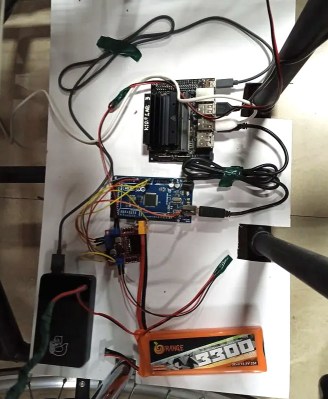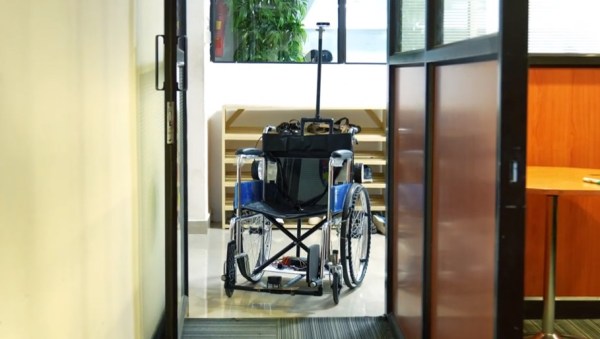What the Flock? It’s probably just some quirk of The Almighty Algorithm, but ever since we featured a story on Flock’s crime-fighting drones last week, we’ve been flooded with other stories about the company, some of which aren’t very flattering. The first thing that we were pushed was this handy interactive map of the company’s network of automatic license plate readers. We had no idea how extensive the network was, and while our location is relatively free from these devices, at least ones operated on behalf of state, county, or local law enforcement, we did learn to our dismay that our local Lowe’s saw fit to install three of these cameras on the entrances to their parking lot. Not wishing to have our coming and goings documented, we’ll be taking our home improvement dollars elsewhere for now.
self-driving53 Articles
Hackaday Links: June 15, 2025
Are robotaxis poised to be the Next Big Thing™ in North America? It seems so, at least according to Goldman Sachs, which issued a report this week stating that robotaxis have officially entered the commercialization phase of the hype cycle. That assessment appears to be based on an analysis of the total ride-sharing market, which encompasses services that are currently almost 100% reliant on meat-based drivers, such as Lyft and Uber, and is valued at $58 billion. Autonomous ride-hailing services like Waymo, which has a fleet of 1,500 robotaxis operating in several cities across the US, are included in that market but account for less than 1% of the total right now. But, Goldman projects that the market will burgeon to over $336 billion in the next five years, driven in large part by “hyperscaling” of autonomous vehicles.
Training A Self-Driving Kart
There are certain tasks that humans perform every day that are notoriously difficult for computers to figure out. Identifying objects in pictures, for example, was something that seems fairly straightforward but was only done by computers with any semblance of accuracy in the last few years. Even then, it can’t be done without huge amounts of computing resources. Similarly, driving a car is a surprisingly complex task that even companies promising full self-driving vehicles haven’t been able to deliver despite working on the problem for over a decade now. [Austin] demonstrates this difficulty in his latest project, which adds self-driving capabilities to a small go-kart.
[Austin] had been working on this project at the local park but grew tired of packing up all his gear when he wanted to work on his machine-learning algorithms. So he took all the self-driving equipment off of the first kart and incorporated it into a smaller kart with a very small turning radius so he could develop it in his shop.
He laid down some tape on the floor to create the track and then set up the vehicle to learn how to drive by watching and gathering data. The model is trained with a convolutional neural network and this data. The only inputs that the model gets are images from cameras at the front of the kart. At first, it could only change the steering angle, with [Austin] controlling the throttle to prevent crashes. Eventually, he gave it control of the throttle as well, which behaves well except at the fastest speeds.
There were plenty of challenges along the way, especially when compared to the models trained at the park; [Austin] correctly theorized that the cause of the hardship in the park was a lack of contrast at the boundary between the track and any out-of-bounds areas. With a few tweaks to the track, as well as adding some wide-angle lenses to his cameras, he was able to get a model that works fairly well. Getting started on a project like this doesn’t have as high of a barrier to entry as one might imagine, either. Take a look at this comprehensive open-source Python library for self-driving projects. If you want to start smaller, perhaps don’t start with a self-driving kart.
Hackaday Links: December 15, 2024
It looks like we won’t have Cruise to kick around in this space anymore with the news that General Motors is pulling the plug on its woe-beset robotaxi project. Cruise, which GM acquired in 2016, fielded autonomous vehicles in various test markets, but the fleet racked up enough high-profile mishaps (first item) for California regulators to shut down test programs in the state last year. The inevitable layoffs ensued, and GM is now killing off its efforts to build robotaxis to concentrate on incorporating the Cruise technology into its “Super Cruise” suite of driver-assistance features for its full line of cars and trucks. We feel like this might be a tacit admission that surmounting the problems of fully autonomous driving is just too hard a nut to crack profitably with current technology, since Super Cruise uses eye-tracking cameras to make sure the driver is paying attention to the road ahead when automation features are engaged. Basically, GM is admitting there still needs to be meat in the seat, at least for now.
Hackaday Links: October 29, 2023
“As California goes, so goes the nation.” That adage has been true on and off for the last 100 years or so, and it’s true again now that GM’s Cruise self-driving car unit has halted operations across the United States, just a couple of days after California’s DMV suspended its license to conduct driverless tests on state roadways. The nationwide shutdown of testing was undertaken voluntarily by the company and takes their sore beset self-driving taxi fleet off the road in Phoenix, Houston, Austin, Dallas, and Miami, in addition to the California ban, which seemed to be mainly happening in San Francisco. Cruise’s fleet has suffered all manner of indignities over the last few months, from vandalism to “coning” pranks to even being used as rolling hookup spots, and that’s not to mention all the trouble they caused by brigading to the same address or losing games of chicken with a semi and a firetruck. We’re not sure what to make of all this; despite our somewhat snarky commentary on the company’s woes, we take little pleasure in this development other than to the degree it probably increases roadway safety in the former test cities. We really do want to see self-driving cars succeed, at least for certain use cases, but it seems like this is a case of too much, too soon for the technology we currently have at our disposal.
Full Self-Driving, On A Budget
Self-driving is currently the Holy Grail in the automotive world, with a number of companies racing to build general-purpose autonomous vehicles that can get from point A to point B with no user input. While no one has brought one to market yet, at least one has promised this feature and had customers pay for it, but continually moved the goalposts for delivery due to how challenging this problem turns out to be. But it doesn’t need to be that hard or expensive to solve, at least in some situations.
The situation in question is driving on a single stretch of highway, and only focuses on steering, so it doesn’t handle the accelerator or brake pedal input. The highway is driven normally, using a webcam to take images of the route and an Arduino to capture data about the steering angle. The idea here is that with enough training the Arduino could eventually steer the car. But first some math needs to happen on the training data since the steering wheel is almost always not turning the car, so the Arduino knows that actual steering events aren’t just statistical anomalies. After the training, the system does a surprisingly good job at “driving” based on this data, and does it on a budget not much larger than laptop, microcontroller, and webcam.
Admittedly, this project was a proof-of-concept to investigate machine learning, neural networks, and other statistical algorithms used in these sorts of systems, and doesn’t actually drive any cars on any roadways. Even the creator says he wouldn’t trust it himself, but that he was pleasantly surprised by the results of such a simple system. It could also be expanded out to handle brake and accelerator pedals with separate neural networks as well. It’s not our first budget-friendly self-driving system, either. This one makes it happen with the enormous computing resources of a single Android smartphone.
Autonomous Wheelchair Lets Jetson Do The Driving
Compared to their manual counterparts, electric wheelchairs are far less demanding to operate, as the user doesn’t need to have upper body strength normally required to turn the wheels. But even a motorized wheelchair needs some kind of input from the user to control it, which still may pose a considerable challenge depending on the individual’s specific abilities.
Hoping to improve on the situation, [Kabilan KB] has developed a self-driving electric wheelchair that can navigate around obstacles by feeding the output of an Intel RealSense Depth Camera and LiDAR module into a Jetson Nano Developer Kit running OpenCV. To control the actual motors, the Jetson is connected to an Arduino which in turn is wired into a common L298N motor driver board.
 As [Kabilan] explains on the NVIDIA Blog, he specifically chose off-the-shelf components and the most affordable electric wheelchair he could find to bring the total cost of the project as low as possible. An undergraduate from the Karunya Institute of Technology and Sciences in Coimbatore, India, he notes that this sort of assistive technology is usually only available to more affluent patients. With his cost-saving measures, he hopes to address that imbalance.
As [Kabilan] explains on the NVIDIA Blog, he specifically chose off-the-shelf components and the most affordable electric wheelchair he could find to bring the total cost of the project as low as possible. An undergraduate from the Karunya Institute of Technology and Sciences in Coimbatore, India, he notes that this sort of assistive technology is usually only available to more affluent patients. With his cost-saving measures, he hopes to address that imbalance.
While automatic obstacle avoidance would already be a big help for many users, [Kabilan] imagines improved software taking things a step further. For example, a user could simply press a button to indicate which room of the house they want to move to, and the chair could drive itself there automatically. With increasingly powerful single-board computers and the state of open source self-driving technology steadily improving, it’s not hard to imagine a future where this kind of technology is commonplace.














